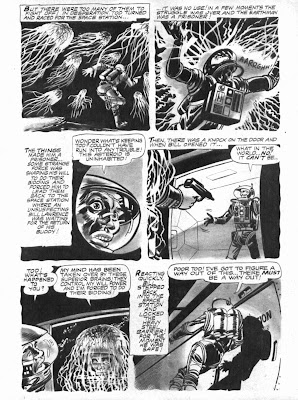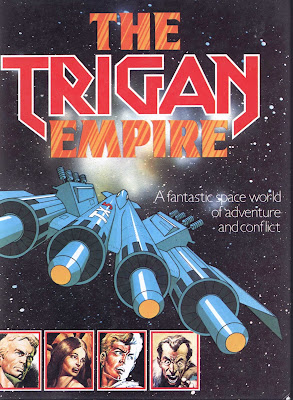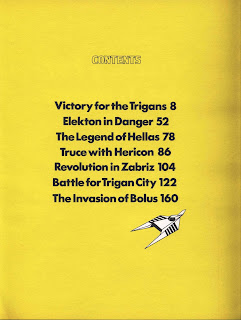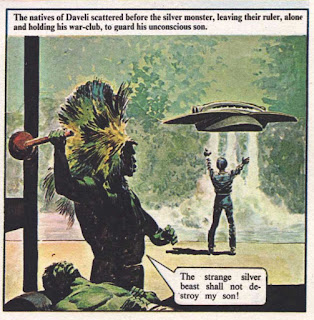The Trigan Empire
by Mike Butterworth (story) and Don Lawrence (art)
Crescent Books, 1978
'The Trigan Empire' (189 pp) was published by Crescent Books in 1978.
'The Trigan Empire' was a British science-fiction comic that first appeared in September 1965 in the magazine Ranger, before transitioning to the magazine Look and Learn in 1966, after which it ran for an impressive 854 issues until April,1982.
This Crescent book - back in 1978, the term 'graphic novel' didn't really exist - compiles episodes from 1965 - 1968. It's not an overly quality-conscious effort; Crescent was a 'budget' publisher whose titles dominated the contents of the remainder tables in bookstores throughout the US in the 70s. This book is 'bare bones'; it lacks any sort of Introduction or Preface that provides information about the comics or their creators.
The narrative relates the History of the Trigan Empire, which flourished long, long ago on Elekton, an Earth-like planet located in a distant galaxy.
The initial episodes describe the founding of the Empire by a bronze-age nomadic tribe led by the brothers Trigo and Brag. Although severely outgunned by the technologically superior Lokans, the warmongering tribe who seek to conquer all of Elekton, the bravery and resourcefulness of Trigo and Brag wins the day, and allows the Trigan Empire to become established as a global power.
The remaining episodes in the compilation deal with various challenges and plots to the supremacy of Trigo and Brag; increasingly, the narrative features as lead protagonists two boys, Janno and Keren, with whom the readership of Look and Learn would more closely identify.
The scripting for these episodes was done by Mike Butterworth, who wrote the majority of the scripts for the series.
Butterworth's plots are simple and straightforward, obviously reflecting the fact that the strip was appearing in a magazine for a juvenile readership. The Trigan Empire regularly finds itself threatened by conspiracies and plots from within, as well as the machinations of the other, hostile civilizations of Elekton. That said, although wordy compared to modern sf comics, Butterworth's scripts are fast-moving and entertaining, and succeed in holding the attention of the reader, something that many contemporary US comics are not able to do.
Indeed, I thought the level of the writing also is quite sophisticated by comparison with contemporary comics for kids and tweeners, which are necessarily simplistic, as they are aimed at a generation of 'post-literate' readers who perpetually are glued to tablets and smartphones.
It's also surprising to see how many deaths are depicted in 'Trigan', particularly when you remember it was published in a magazine for kids; although these deaths are never depicted in a graphic manner, they are part of the overall moral message of the series, i..e, good triumphs, and evil will eventually be punished. It's doubtful that as high a body count - which often is mediated by falling from great heights - would be permitted in any contemporary children's comic..........
The pages of this Crescent Books compilation appear to have been generated from photographs of copies of Look and Learn, rather than the original artwork.
Despite the low-res quality of the reproductions, the cheaper grade of paper, and the poor color separations of this compilation, the high caliber of the artwork and the coloring used in the original series still is apparent. (Although Don Lawrence is the name most associated with the Trigan comics, a number of other artists also contributed.)
The artistic team is adept at drawing human faces and expressions, buildings, landscapes, futuristic vehicles, and even a monster or two. The draftsmanship on display in these comics from the mid-60s remains unsurpassed by anything in contemporary graphic art.
Stylistically, 'The Trigan Empire' is an offbeat mix of Greco-Roman culture and architecture; most of the narrative takes place among tribes situated in Mediterranean-like desert and mountain landscapes.
The spaceships, military vehicles, and weapons wielded by the inhabitants of Elekton are of the postwar, Atomic Age variety:
Summing up, 'The Trigan Empire' remains one of the high points of British sf comics.
Sadly, finding a copy of this book at an affordable price is difficult (those advertised on amazon start at $161, which is very steep). Hopefully a more affordable reprint collection will be produced in the coming years.......















































































